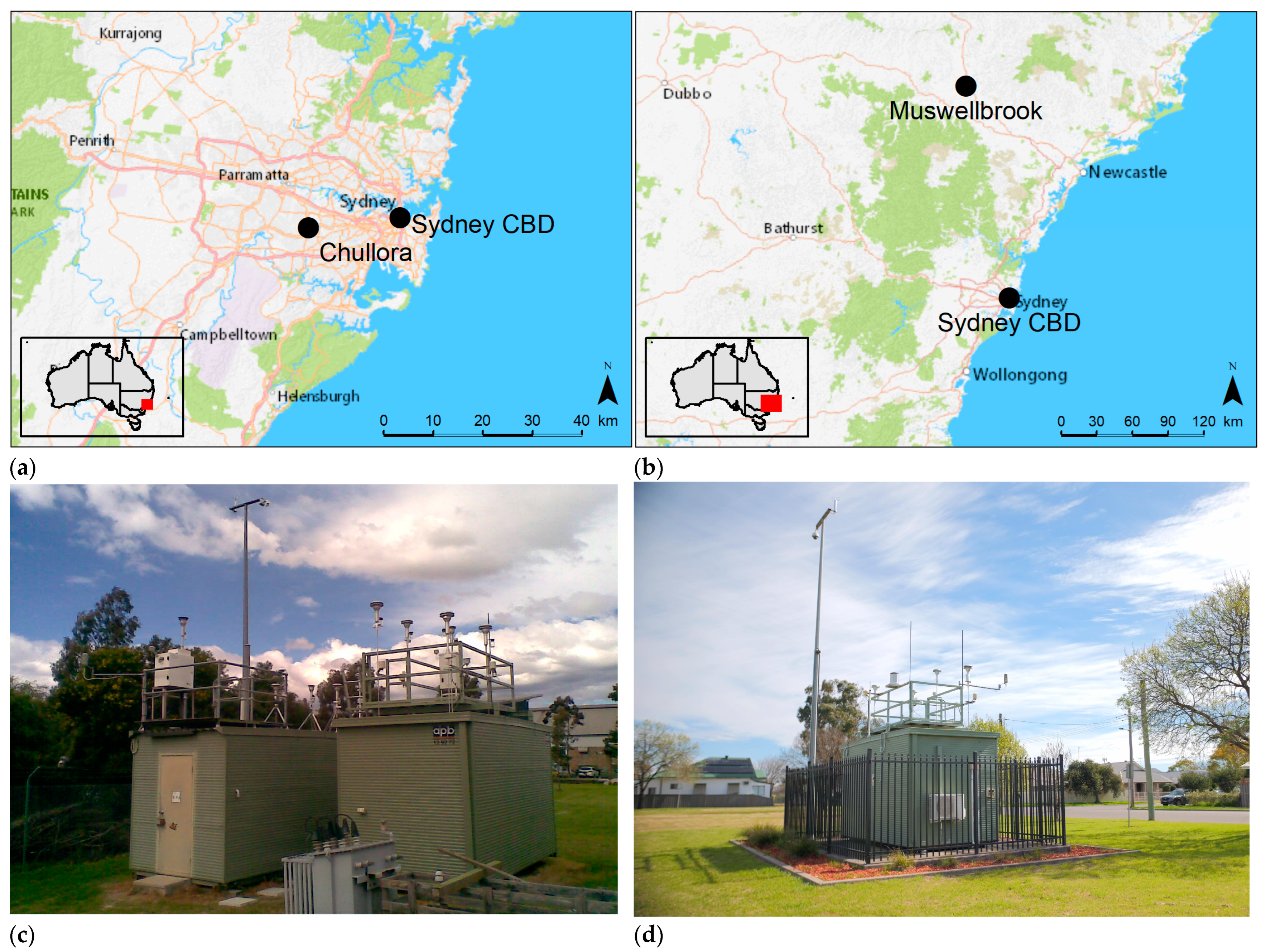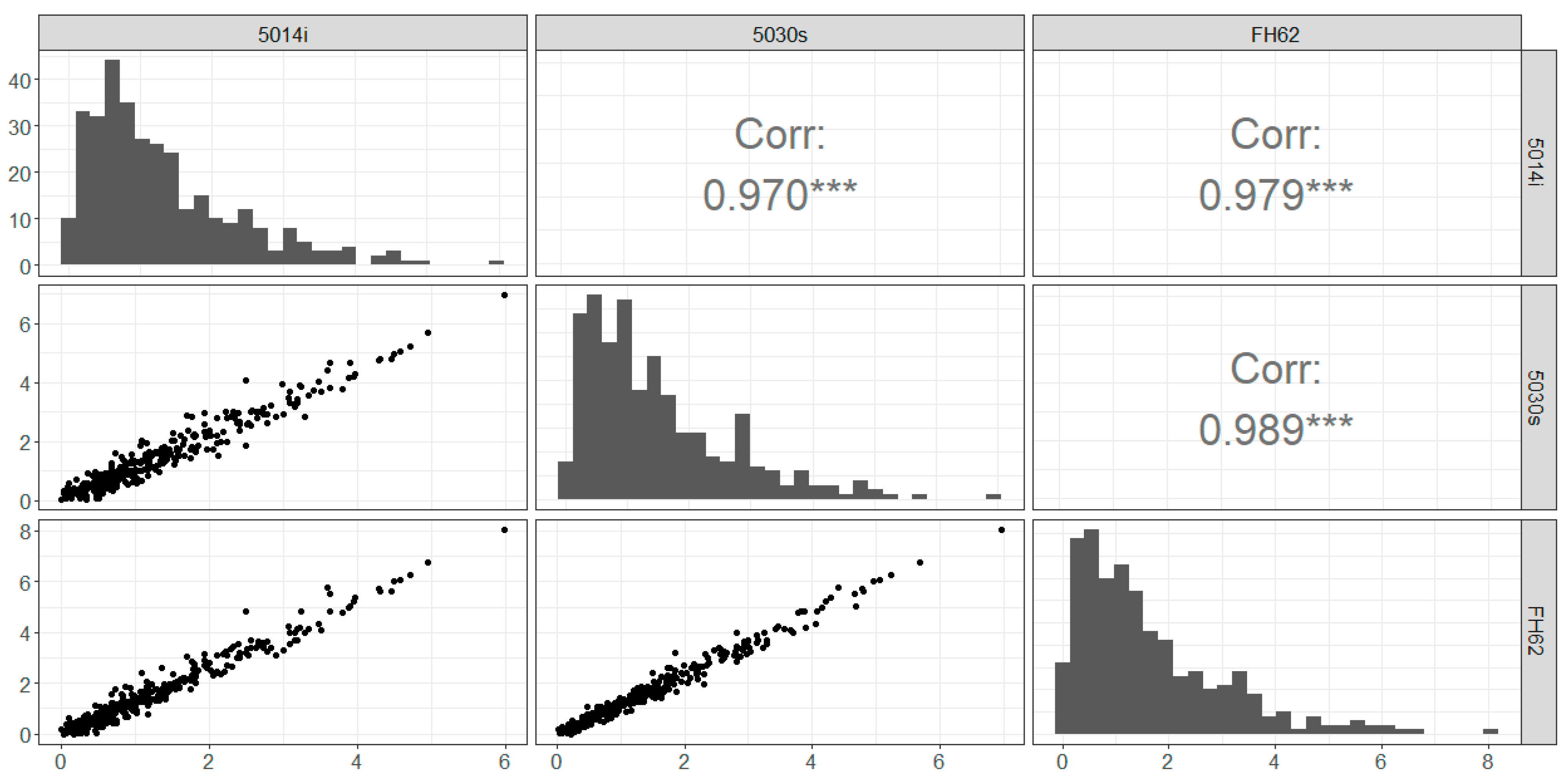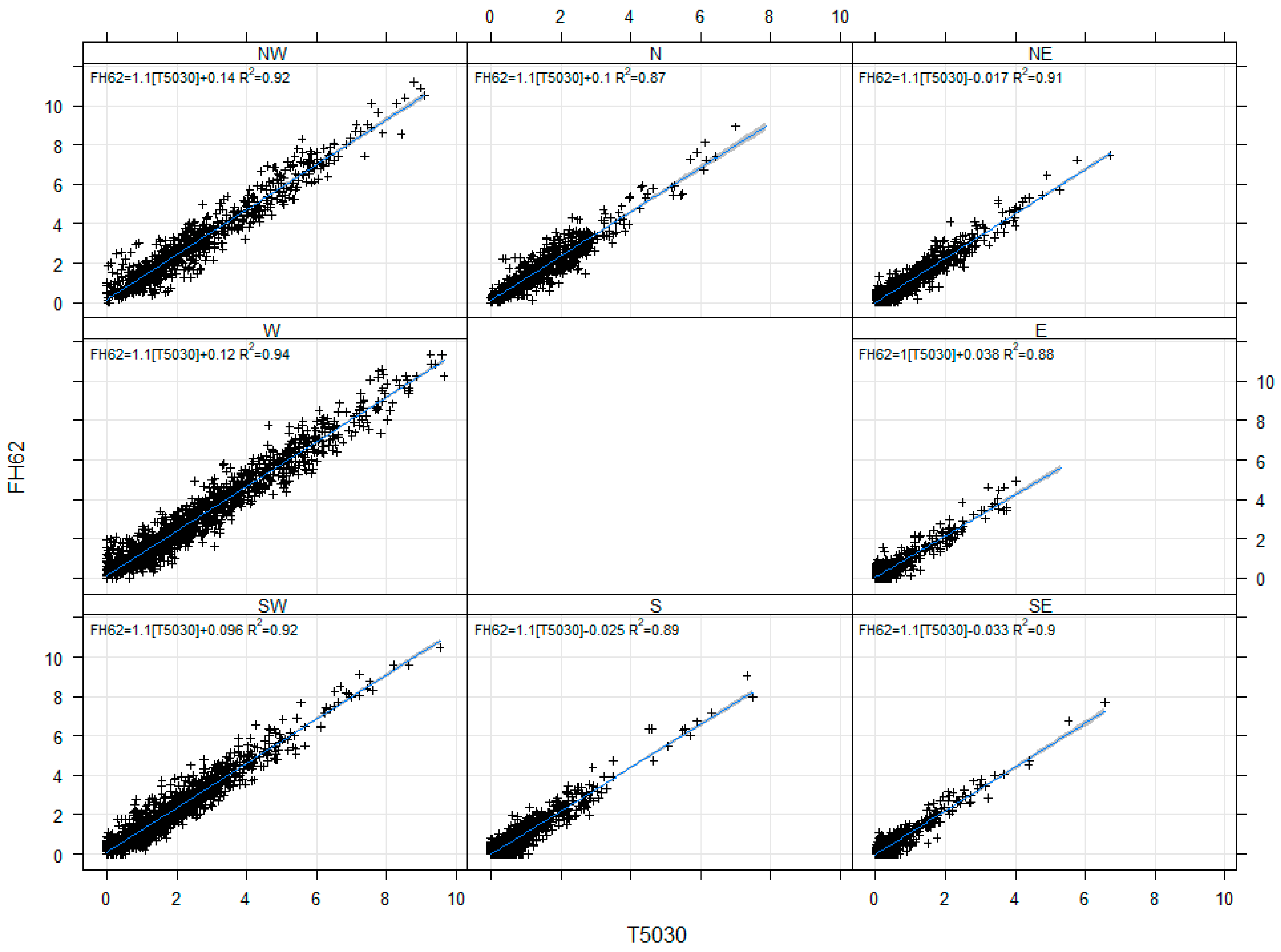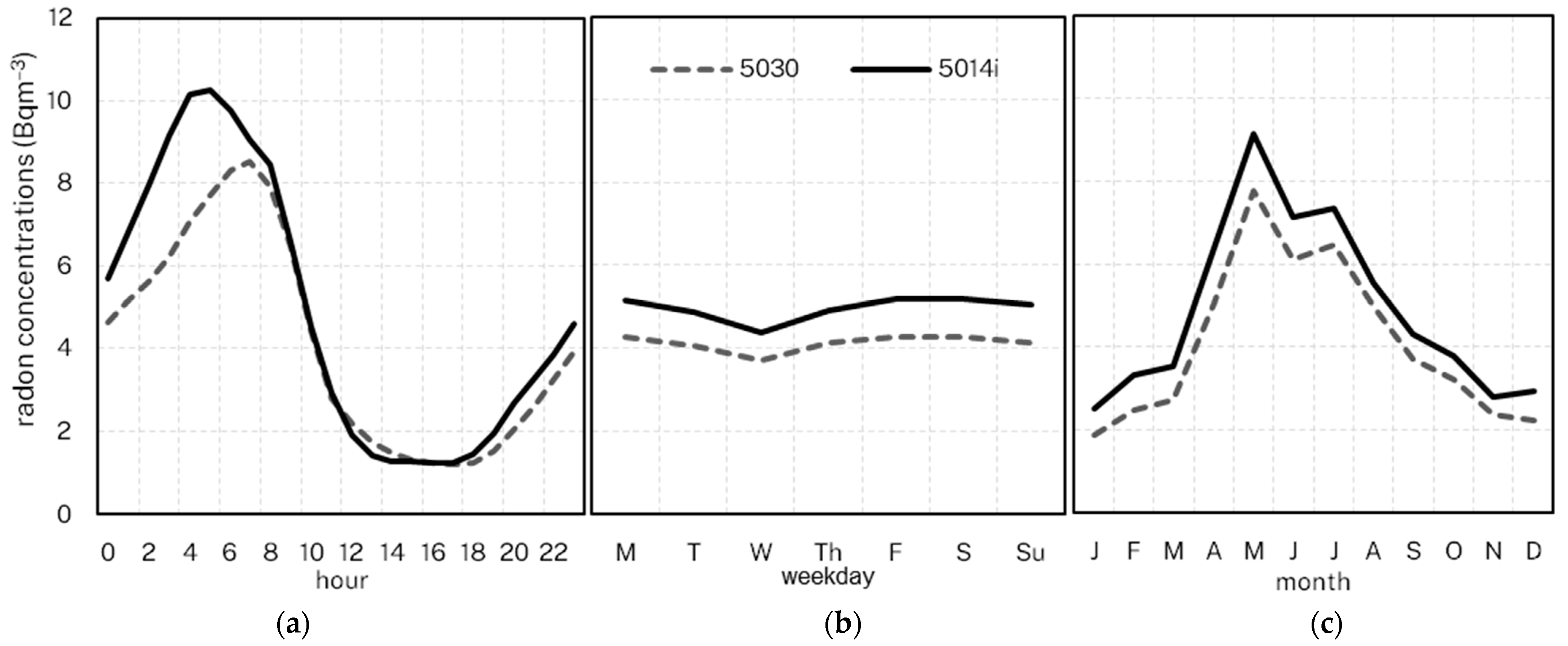Assessing the Precision of Radon Measurements from Beta-Attenuation Monitors
Abstract
1. Introduction
2. Materials and Methods
2.1. Site Locations
2.2. Study Period
2.3. Instrumentation
- = detection efficiency of α particles
- = gross α particle count rate [s−1]
- = background α particle count rate (unloaded filter) [s−1]
- = air flow [m3 s−1]
- = 4550 s; equilibrium constant for 222Rn daughter nuclides
- = activity concentration of 218Po
- = activity concentration of 214Pb
- = activity concentration of 214Bi
2.4. Data Handling and Analysis
3. Results
3.1. Annual and Monthly Mean Concentrations and Data Distributions—Chullora
3.2. Diurnal, Weekday-Weekend and Monthly Variability Comparisons—Chullora
3.3. Environmental Dependencies—Chullora
3.4. Annual and Monthly Mean Concentrations and Data Distributions—Muswellbrook
3.5. Diurnal, Weekday-Weekend and Monthly Variability Comparisons—Muswellbrook
3.6. Environmental Dependencies—Muswellbrook
4. Discussion
5. Conclusions
Supplementary Materials
Author Contributions
Funding
Data Availability Statement
Conflicts of Interest
References
- Pearson, J.E.; Jones, G.E. Soil concentrations of “emanating radium-226” and the emanation of radon-222 from soils and plants. Tellus 1966, 18, 655–662. [Google Scholar] [CrossRef]
- Fricke, R.G.; Schlegel, K. Julius Elster and Hans Geitel–Dioscuri of physics and pioneer investigators in atmospheric electricity. Hist. Geo-Space Sci. 2017, 8, 1–7. [Google Scholar] [CrossRef]
- Dörr, H.; Kromer, B.; Levin, I.; Münnich, K.; Volpp, H.J. CO2 and radon 222 as tracers for atmospheric transport. J. Geophys. Res. Oceans 1983, 88, 1309–1313. [Google Scholar] [CrossRef]
- Polian, G.; Lambert, G.; Ardouin, B.; Jegou, A. Long-range transport of continental radon in subantarctic and antarctic areas. Tellus B Chem. Phys. Meteorol. 1986, 38, 178–189. [Google Scholar] [CrossRef]
- Chambers, S.D.; Williams, A.G.; Conen, F.; Griffiths, A.D.; Reimann, S.; Steinbacher, M.; Krummel, P.B.; Steele, L.P.; van der Schoot, M.V.; Galbally, I.E.; et al. Towards a universal “baseline” characterisation of air masses for high- and low-altitude observing stations using Radon-222. Aero. Air Qual. Res. 2015, 16, 885–899. [Google Scholar] [CrossRef]
- Jacob, D.J.; Prather, M.J.; Rasch, P.J.; Shia, R.L.; Balkanski, Y.J.; Beagley, S.R.; Bergmann, D.J.; Blackshear, W.; Brown, M.; Chiba, M. Evaluation and intercomparison of global atmospheric transport models using 222Rn and other short-lived tracers. J. Geophys. Res. Atmos. 1997, 102, 5953–5970. [Google Scholar] [CrossRef]
- Zhang, K.; Wan, H.; Zhang, M.; Wang, B. Evaluation of the atmospheric transport in a GCM using radon measurements: Sensitivity to cumulus convection parameterization. Atmos. Chem. Phys. 2008, 8, 2811–2832. [Google Scholar] [CrossRef]
- Zhang, B.; Liu, H.; Crawford, J.H.; Chen, G.; Fairlie, T.D.; Chambers, S.; Kang, C.-H.; Williams, A.G.; Zhang, K.; Considine, D.B. Simulation of radon-222 with the GEOS-Chem global model: Emissions, seasonality, and convective transport. Atmos. Chem. Phys. 2021, 21, 1861–1887. [Google Scholar] [CrossRef]
- Chambers, S.D.; Guérette, E.-A.; Monk, K.; Griffiths, A.D.; Zhang, Y.; Duc, H.; Cope, M.; Emmerson, K.M.; Chang, L.T.; Silver, J.D. Skill-testing chemical transport models across contrasting atmospheric mixing states using Radon-222. Atmosphere 2019, 10, 25. [Google Scholar] [CrossRef]
- Williams, A.G.; Zahorowski, W.; Chambers, S.; Griffiths, A.; Hacker, J.M.; Element, A.; Werczynski, S. The vertical distribution of radon in clear and cloudy daytime terrestrial boundary layers. J. Atmos. Sci. 2011, 68, 155–174. [Google Scholar] [CrossRef]
- Williams, A.G.; Chambers, S.; Griffiths, A. Bulk Mixing and Decoupling of the Nocturnal Stable Boundary Layer Characterized Using a Ubiquitous Natural Tracer. Bound.-Layer Meteorol. 2013, 149, 381–402. [Google Scholar] [CrossRef]
- Chambers, S.; Williams, A.; Zahorowski, W.; Griffiths, A.; Crawford, J. Separating remote fetch and local mixing influences on vertical radon measurements in the lower atmosphere. Tellus B Chem. Phys. Meteorol. 2011, 63, 843–859. [Google Scholar] [CrossRef]
- Vecchi, R.; Piziali, F.; Valli, G.; Favaron, M.; Bernardoni, V. Radon-based estimates of equivalent mixing layer heights: A long-term assessment. Atmos. Environ. 2019, 197, 150–158. [Google Scholar] [CrossRef]
- Crawford, J.; Chambers, S.D.; Williams, A.G. Assessing the impact of synoptic weather systems on air quality in Sydney using Radon 222. Atmos. Environ. 2023, 295, 119537. [Google Scholar] [CrossRef]
- Williams, A.G.; Chambers, S.D.; Conen, F.; Reimann, S.; Hill, M.; Griffiths, A.D.; Crawford, J. Radon as a tracer of atmospheric influences on traffic-related air pollution in a small inland city. Tellus B Chem. Phys. Meteorol. 2016, 68, 30967. [Google Scholar] [CrossRef]
- Chambers, S.; Podstawczyńska, A.; Pawlak, W.; Fortuniak, K.; Williams, A.; Griffiths, A. Characterizing the state of the urban surface layer using radon-222. J. Geophys. Res. Atmos. 2019, 124, 770–788. [Google Scholar] [CrossRef]
- Kikaj, D.; Chambers, S.D.; Crawford, J.; Kobal, M.; Gregorič, A.; Vaupotič, J. Investigating the vertical and spatial extent of radon-based classification of the atmospheric mixing state and impacts on seasonal urban air quality. Sci. Total Environ. 2023, 872, 162126. [Google Scholar] [CrossRef] [PubMed]
- Levin, I.; Glatzel-Mattheier, H.; Marik, T.; Cuntz, M.; Schmidt, M.; Worthy, D.E. Verification of German methane emission inventories and their recent changes based on atmospheric observations. J. Geophys. Res. Atmos. 1999, 104, 3447–3456. [Google Scholar] [CrossRef]
- Vogel, F.; Ishizawa, M.; Chan, E.; Chan, D.; Hammer, S.; Levin, I.; Worthy, D. Regional non-CO2 greenhouse gas fluxes inferred from atmospheric measurements in Ontario, Canada. J. Integr. Environ. Sci. 2012, 9, 41–55. [Google Scholar] [CrossRef]
- Grossi, C.; Vogel, F.R.; Curcoll, R.; Àgueda, A.; Vargas, A.; Rodó, X.; Morguí, J.-A. Study of the daily and seasonal atmospheric CH4 mixing ratio variability in a rural Spanish region using 222 Rn tracer. Atmos. Chem. Phys. 2018, 18, 5847–5860. [Google Scholar] [CrossRef]
- Al-Zoughool, M.; Krewski, D. Health effects of radon: A review of the literature. Int. J. Radiat. Biol. 2009, 85, 57–69. [Google Scholar] [CrossRef] [PubMed]
- Riudavets, M.; Garcia de Herreros, M.; Besse, B.; Mezquita, L. Radon and lung cancer: Current trends and future perspectives. Cancers 2022, 14, 3142. [Google Scholar] [CrossRef] [PubMed]
- Blomberg, A.J.; Coull, B.A.; Jhun, I.; Vieira, C.L.; Zanobetti, A.; Garshick, E.; Schwartz, J.; Koutrakis, P. Effect modification of ambient particle mortality by radon: A time series analysis in 108 US cities. J. Air Waste Manag. Assoc. 2019, 69, 266–276. [Google Scholar] [CrossRef] [PubMed]
- World Meteorological Organization. GAW Report No. 172. WMO Global Atmosphere Watch (GAW) Strategic Plan: 2008–2015—A Contribution to the Implementation of the WMO Strategic Plan: 2008–2011; WMO: Geneva, Switzerland, 2007; 108p. [Google Scholar]
- Heiskanen, J.; Brümmer, C.; Buchmann, N.; Calfapietra, C.; Chen, H.; Gielen, B.; Gkritzalis, T.; Hammer, S.; Hartman, S.; Herbst, M. The integrated carbon observation system in Europe. Bull. Am. Meteorol. Soc. 2022, 103, E855–E872. [Google Scholar] [CrossRef]
- Čeliković, I.; Pantelić, G.; Vukanac, I.; Krneta Nikolić, J.; Živanović, M.; Cinelli, G.; Gruber, V.; Baumann, S.; Quindos Poncela, L.S.; Rabago, D. Outdoor radon as a tool to estimate radon priority areas—A literature overview. Int. J. Environ. Res. Public Health 2022, 19, 662. [Google Scholar] [CrossRef] [PubMed]
- Williams, A.; Chambers, S. A History of Radon Measurements at Cape Grim. Baseline Atmospheric Program (Australia) History and Recollections, In 40th Anniversary Special ed.; Bureau of Meteorology and CSIRO: Melbourne, Australia, 2016; pp. 131–146. [Google Scholar] [CrossRef]
- Levin, I.; Born, M.; Cuntz, M.; Langendörfer, U.; Mantsch, S.; Naegler, T.; Schmidt, M.; Varlagin, A.; Verclas, S.; Wagenbach, D. Observations of atmospheric variability and soil exhalation rate of radon-222 at a Russian forest site. Technical approach and deployment for boundary layer studies. Tellus B Chem. Phys. Meteorol. 2002, 54, 462–475. [Google Scholar] [CrossRef][Green Version]
- Wada, A.; Murayama, S.; Kondo, H.; Matsueda, H.; Sawa, Y.; Tsuboi, K. Development of a compact and sensitive electrostatic radon-222 measuring system for use in atmospheric observation. J. Meteorol. Soc. Japan. Ser. II 2010, 88, 123–134. [Google Scholar] [CrossRef]
- Grossi, C.; Vargas, A.; Camacho, A.; López-Coto, I.; Bolívar, J.; Xia, Y.; Conen, F. Inter-comparison of different direct and indirect methods to determine radon flux from soil. Radiat. Meas. 2011, 46, 112–118. [Google Scholar] [CrossRef]
- Whittlestone, S.; Zahorowski, W. Baseline radon detectors for shipboard use: Development and deployment in the First Aerosol Characterization Experiment (ACE 1). J. Geophys. Res. Atmos. 1998, 103, 16743–16751. [Google Scholar] [CrossRef]
- Griffiths, A.D.; Chambers, S.D.; Williams, A.G.; Werczynski, S. Increasing the accuracy and temporal resolution of two-filter radon–222 measurements by correcting for the instrument response. Atmos. Meas. Tech. 2016, 9, 2689–2707. [Google Scholar] [CrossRef]
- Chambers, S.D.; Preunkert, S.; Weller, R.; Hong, S.-B.; Humphries, R.S.; Tositti, L.; Angot, H.; Legrand, M.; Williams, A.G.; Griffiths, A.D. Characterizing atmospheric transport pathways to Antarctica and the remote Southern Ocean using radon-222. Front. Earth Sci. 2018, 6, 190. [Google Scholar] [CrossRef]
- Xia, Y.; Sartorius, H.; Schlosser, C.; Stöhlker, U.; Conen, F.; Zahorowski, W. Comparison of one-and two-filter detectors for atmospheric 222 Rn measurements under various meteorological conditions. Atmos. Meas. Tech. 2010, 3, 723–731. [Google Scholar] [CrossRef]
- Schmithüsen, D.; Chambers, S.; Fischer, B.; Gilge, S.; Hatakka, J.; Kazan, V.; Neubert, R.; Paatero, J.; Ramonet, M.; Schlosser, C. A European-wide 222 radon and 222 radon progeny comparison study. Atmos. Meas. Tech. 2017, 10, 1299–1312. [Google Scholar] [CrossRef]
- Grossi, C.; Chambers, S.D.; Llido, O.; Vogel, F.R.; Kazan, V.; Capuana, A.; Werczynski, S.; Curcoll, R.; Delmotte, M.; Vargas, A. Intercomparison study of atmospheric 222 Rn and 222 Rn progeny monitors. Atmos. Meas. Tech. 2020, 13, 2241–2255. [Google Scholar] [CrossRef]
- Macias, E.S.; Husar, R.B. Atmospheric particulate mass measurement with beta attenuation mass monitor. Environ. Sci. Technol. 1976, 10, 904–907. [Google Scholar] [CrossRef]
- Riley, M.L.; Chambers, S.D.; Williams, A.G. Inter-Comparison of Radon Measurements from a Commercial Beta-Attenuation Monitor and ANSTO Dual Flow Loop Monitor. Atmosphere 2023, 14, 1333. [Google Scholar] [CrossRef]
- Perrino, C.; Pietrodangelo, A.; Febo, A. An atmospheric stability index based on radon progeny measurements for the evaluation of primary urban pollution. Atmos. Environ. 2001, 35, 5235–5244. [Google Scholar] [CrossRef]
- Chambers, S.D.; Wang, F.; Williams, A.G.; Xiaodong, D.; Zhang, H.; Lonati, G.; Crawford, J.; Griffiths, A.D.; Ianniello, A.; Allegrini, I. Quantifying the influences of atmospheric stability on air pollution in Lanzhou, China, using a radon-based stability monitor. Atmos. Environ. 2015, 107, 233–243. [Google Scholar] [CrossRef]
- Wang, F.; Zhang, Z.; Chambers, S.D.; Tian, X.; Zhu, R.; Mei, M.; Huang, Z.; Allegrini, I. Quantifying influences of nocturnal mixing on air quality using an atmospheric radon measurement case study in the city of jinhua, China. Aerosol Air Qual. Res. 2020, 20, 620–629. [Google Scholar] [CrossRef]
- Riley, M.; Kirkwood, J.; Jiang, N.; Ross, G.; Scorgie, Y. Air quality monitoring in NSW: From long term trend monitoring to integrated urban services. Air Qual. Clim. Chang. 2020, 54, 44–51. [Google Scholar]
- Sahukar, R.; Gallery, C.; Smart, J.; Mitchell, P. The Bioregions of New South Wales: Their Biodiversity, Conservation and History; National Parks and Wildlife Service NSW: Dubbo, Australia, 2003. [Google Scholar]
- Bureau of Meteorology. Sydney in 2011: Warm, Wet Year for Sydney. Available online: http://www.bom.gov.au/climate/current/annual/nsw/archive/2011.sydney.shtml (accessed on 20 September 2023).
- Bureau of Meteorology. Sydney in 2012: Average Conditions Hide a Year of Two Halves. Available online: http://www.bom.gov.au/climate/current/annual/nsw/archive/2012.sydney.shtml (accessed on 20 September 2023).
- Bureau of Meteorology. Recent and Historical Rainfall Maps—Thirty-Six-Monthly Rainfall Deciles for New South Wales/ACT 01/09/2015–31/08/2018. Available online: http://www.bom.gov.au/climate/maps/rainfall/?variable=rainfall&map=decile&period=36month®ion=ns&year=2018&month=08&day=31 (accessed on 13 October 2023).
- Bureau of Meteorology. Archive—Twelve-Monthly Mean Temperature Decile for New South Wales/ACT. Available online: http://www.bom.gov.au/jsp/awap/temp/archive.jsp?colour=colour&map=meandecile&year=2018&month=8&period=12month&area=ns (accessed on 13 October 2023).
- Chambers, S.; Williams, A.; Crawford, J.; Griffiths, A. On the use of radon for quantifying the effects of atmospheric stability on urban emissions. Atmos. Chem. Phys. 2015, 15, 1175–1190. [Google Scholar] [CrossRef]
- International Commission on Radiological Protection (ICRP). Protection against radon-222 at home and at work (ICRP Publication 65). In Annals of the ICRP; International Commission on Radiological Protection: Ottawa, ON, Canada, 1993; Volume 23. [Google Scholar]
- Kataoka, T. Diurnal variation in radon concentration and mixing-layer depths. Bound.-Layer Meteorol. 1998, 89, 225–250. [Google Scholar] [CrossRef]
- Kataoka, T.; Yunoki, E.; Shimizu, M.; Mori, T.; Tsukamoto, O.; Ohashi, Y.; Sahashi, K.; Maitani, T.; Miyashita, K.I.; Iwata, T. A study of the atmospheric boundary layer using radon and air pollutants as tracers. Bound.-Layer Meteorol. 2001, 101, 131–156. [Google Scholar] [CrossRef]
- Dörr, H.; Münnich, K. Annual variation in soil respiration in selected areas of the temperate zone. Tellus B 1987, 39, 114–121. [Google Scholar] [CrossRef]
- Oke, T.R. Boundary Layer Climates, 2nd ed.; Routledge: London, UK; New York, NY, USA, 2002; pp. 20–27. [Google Scholar]
- Röttger, A.; Röttger, S.; Grossi, C.; Vargas, A.; Curcoll, R.; Otáhal, P.; Hernández-Ceballos, M.Á.; Cinelli, G.; Chambers, S.; Barbosa, S.A. New metrology for radon at the environmental level. Meas. Sci. Technol. 2021, 32, 124008. [Google Scholar] [CrossRef]
- Chambers, S.D.; Griffiths, A.D.; Williams, A.G.; Sisoutham, O.; Morosh, V.; Röttger, S.; Mertes, F.; Röttger, A. Portable two-filter dual-flow-loop 222 Rn detector: Stand-alone monitor and calibration transfer device. Adv. Geosci. 2022, 57, 63–80. [Google Scholar] [CrossRef]











| Site | Instrument | Serial Number | Data Capture, Raw (h, %) | Data Capture, Infilled (h, %) |
|---|---|---|---|---|
| Chullora | 5014i | CM09360200 | 7061, 81% | 7958, 91% |
| 5030 SHARP | E-327 | 7272, 83% | 8223, 94% | |
| FH62C14 | E-1757 | 7471, 85% | 8511, 97% | |
| Muswellbrook | 5014i | CM14491004 | 21,158, 81% | 24,910, 95% |
| 5030 SHARP | E-323 | 22,555, 86% | 25,606, 97% |
| Mean | σ | Percentiles | ||||||||||||||||
|---|---|---|---|---|---|---|---|---|---|---|---|---|---|---|---|---|---|---|
| 25th | Median | 75th | 95th | |||||||||||||||
| 5014i | 5030 | FH62 | 5014i | 5030 | FH62 | 5014i | 5030 | FH62 | 5014i | 5030 | FH62 | 5014i | 5030 | FH62 | 5014i | 5030 | FH62 | |
| Jan. | 0.61 | 0.64 | 0.75 | 0.74 | 0.69 | 0.90 | 0.04 | 0.21 | 0.17 | 0.37 | 0.40 | 0.40 | 0.89 | 0.80 | 1.02 | 2.11 | 2.09 | 2.72 |
| Feb. | 0.72 | 0.79 | 0.92 | 0.72 | 0.69 | 0.84 | 0.17 | 0.29 | 0.32 | 0.55 | 0.60 | 0.69 | 1.05 | 1.09 | 1.28 | 2.20 | 2.12 | 2.64 |
| Mar. | 0.68 | 0.87 | 0.90 | 0.87 | 0.95 | 1.05 | 0.06 | 0.23 | 0.21 | 0.43 | 0.56 | 0.57 | 0.89 | 1.17 | 1.19 | 2.45 | 2.86 | 3.04 |
| Apr. | 1.52 | 1.71 | 1.94 | 1.52 | 1.39 | 1.70 | 0.44 | 0.61 | 0.61 | 1.02 | 1.41 | 1.50 | 2.27 | 2.47 | 2.89 | 5.10 | 4.49 | 5.25 |
| May | 2.70 | 2.93 | 3.47 | 1.83 | 2.00 | 2.40 | 1.25 | 1.31 | 1.47 | 2.32 | 2.47 | 2.96 | 3.79 | 4.21 | 4.91 | 6.11 | 6.63 | 8.02 |
| Jun. | 1.45 | 1.83 | 1.85 | 1.42 | 1.55 | 1.82 | 0.43 | 0.71 | 0.44 | 0.95 | 1.39 | 1.43 | 2.19 | 2.53 | 2.68 | 4.22 | 4.97 | 5.79 |
| Jul. | 1.71 | 1.90 | 2.16 | 1.57 | 1.64 | 1.82 | 0.66 | 0.73 | 0.80 | 1.27 | 1.60 | 1.79 | 2.26 | 2.52 | 2.88 | 5.15 | 5.20 | 5.88 |
| Aug. | 2.02 | 2.31 | 2.76 | 1.86 | 2.06 | 2.42 | 0.37 | 0.55 | 0.66 | 1.64 | 1.85 | 2.33 | 3.13 | 3.50 | 4.11 | 5.80 | 6.25 | 7.67 |
| Sep. | 1.42 | 1.61 | 1.45 | 1.37 | 1.49 | 1.35 | 0.45 | 0.56 | 0.42 | 1.07 | 1.21 | 1.01 | 2.01 | 2.20 | 2.15 | 4.34 | 4.88 | 4.07 |
| Oct. | 1.10 | 1.27 | 1.42 | 1.14 | 1.21 | 1.41 | 0.27 | 0.37 | 0.37 | 0.73 | 0.96 | 0.98 | 1.61 | 1.81 | 2.09 | 3.25 | 3.69 | 4.11 |
| Nov. | 1.07 | 1.16 | 1.36 | 0.94 | 0.97 | 1.13 | 0.28 | 0.37 | 0.46 | 0.85 | 0.87 | 1.02 | 1.73 | 1.92 | 2.17 | 2.93 | 2.83 | 3.39 |
| Dec. | 0.57 | 0.57 | 0.59 | 0.66 | 0.63 | 0.75 | 0.00 | 0.14 | 0.11 | 0.36 | 0.37 | 0.32 | 0.84 | 0.73 | 0.78 | 1.82 | 1.86 | 2.20 |
| Ann. | 1.31 | 1.47 | 1.64 | 1.44 | 1.53 | 1.78 | 0.27 | 0.36 | 0.35 | 0.82 | 0.98 | 1.00 | 1.87 | 2.09 | 2.34 | 4.45 | 4.78 | 5.41 |
| Comparison/Variable | Deciles | |||||||||
|---|---|---|---|---|---|---|---|---|---|---|
| 1 | 2 | 3 | 4 | 5 | 6 | 7 | 8 | 9 | 10 | |
| 5030 vs. FH62 | ||||||||||
| Temperature | 0.97 | 0.97 | 0.96 | 0.96 | 0.96 | 0.96 | 0.96 | 0.96 | 0.96 | 0.95 |
| Relative humidity | 0.90 | 0.94 | 0.95 | 0.96 | 0.97 | 0.97 | 0.98 | 0.98 | 0.97 | 0.98 |
| Wind speed | 0.97 | 0.97 | 0.97 | 0.97 | 0.97 | 0.96 | 0.95 | 0.93 | 0.92 | 0.90 |
| Sigma theta | 0.97 | 0.96 | 0.97 | 0.97 | 0.96 | 0.96 | 0.97 | 0.97 | 0.97 | 0.96 |
| 5030 vs. 5014i | ||||||||||
| Temperature | 0.94 | 0.95 | 0.93 | 0.94 | 0.93 | 0.91 | 0.91 | 0.89 | 0.88 | 0.85 |
| Relative humidity | 0.83 | 0.89 | 0.89 | 0.93 | 0.94 | 0.95 | 0.95 | 0.95 | 0.95 | 0.96 |
| Wind speed | 0.94 | 0.95 | 0.94 | 0.95 | 0.94 | 0.93 | 0.91 | 0.85 | 0.82 | 0.73 |
| Sigma theta | 0.92 | 0.93 | 0.94 | 0.94 | 0.93 | 0.93 | 0.94 | 0.94 | 0.93 | 0.93 |
| FH62 vs. 5014i | ||||||||||
| Temperature | 0.95 | 0.96 | 0.96 | 0.95 | 0.95 | 0.93 | 0.92 | 0.89 | 0.88 | 0.88 |
| Relative humidity | 0.87 | 0.91 | 0.91 | 0.95 | 0.95 | 0.96 | 0.96 | 0.96 | 0.96 | 0.96 |
| Wind speed | 0.94 | 0.96 | 0.96 | 0.96 | 0.96 | 0.94 | 0.93 | 0.88 | 0.84 | 0.79 |
| Sigma theta | 0.94 | 0.94 | 0.95 | 0.95 | 0.95 | 0.95 | 0.95 | 0.95 | 0.95 | 0.94 |
| Comparison/Variable | Deciles | |||||||||
|---|---|---|---|---|---|---|---|---|---|---|
| 1 | 2 | 3 | 4 | 5 | 6 | 7 | 8 | 9 | 10 | |
| 5030 vs. 5014i | ||||||||||
| Temperature | 0.97 | 0.97 | 0.97 | 0.97 | 0.96 | 0.95 | 0.93 | 0.92 | 0.86 | 0.73 |
| Relative humidity | 0.94 | 0.85 | 0.92 | 0.95 | 0.96 | 0.97 | 0.97 | 0.97 | 0.98 | 0.97 |
| Wind speed | 0.97 | 0.97 | 0.97 | 0.96 | 0.95 | 0.88 | 0.79 | 0.72 | 0.67 | 0.65 |
| Sigma theta | 0.96 | 0.94 | 0.96 | 0.96 | 0.96 | 0.96 | 0.96 | 0.97 | 0.97 | 0.97 |
Disclaimer/Publisher’s Note: The statements, opinions and data contained in all publications are solely those of the individual author(s) and contributor(s) and not of MDPI and/or the editor(s). MDPI and/or the editor(s) disclaim responsibility for any injury to people or property resulting from any ideas, methods, instructions or products referred to in the content. |
© 2024 by the authors. Licensee MDPI, Basel, Switzerland. This article is an open access article distributed under the terms and conditions of the Creative Commons Attribution (CC BY) license (https://creativecommons.org/licenses/by/4.0/).
Share and Cite
Riley, M.L.; Jiang, N.; Gunashanhar, G.; Thompson, S. Assessing the Precision of Radon Measurements from Beta-Attenuation Monitors. Atmosphere 2024, 15, 83. https://doi.org/10.3390/atmos15010083
Riley ML, Jiang N, Gunashanhar G, Thompson S. Assessing the Precision of Radon Measurements from Beta-Attenuation Monitors. Atmosphere. 2024; 15(1):83. https://doi.org/10.3390/atmos15010083
Chicago/Turabian StyleRiley, Matthew L., Ningbo Jiang, Gunaratnam Gunashanhar, and Scott Thompson. 2024. "Assessing the Precision of Radon Measurements from Beta-Attenuation Monitors" Atmosphere 15, no. 1: 83. https://doi.org/10.3390/atmos15010083
APA StyleRiley, M. L., Jiang, N., Gunashanhar, G., & Thompson, S. (2024). Assessing the Precision of Radon Measurements from Beta-Attenuation Monitors. Atmosphere, 15(1), 83. https://doi.org/10.3390/atmos15010083







